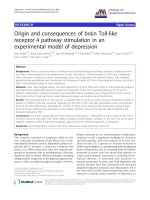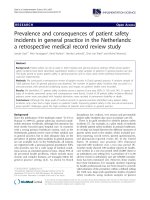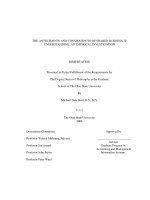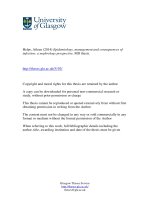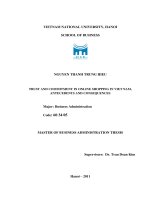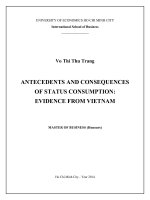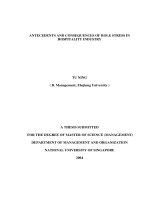Antecedents and consequences of status consumption
Bạn đang xem bản rút gọn của tài liệu. Xem và tải ngay bản đầy đủ của tài liệu tại đây (1.57 MB, 92 trang )
UNIVERSITY OF ECONOMICS HO CHI MINH CITY
International School of Business
Vo Thi Thu Trang
ANTECEDENTS AND CONSEQUENCES
OF STATUS CONSUMPTION:
EVIDENCE FROM VIETNAM
MASTER OF BUSINESS (Honours)
Ho Chi Minh City - Year 2014
UNIVERSITY OF ECONOMICS HO CHI MINH CITY
International School of Business
Vo Thi Thu Trang
ANTECEDENTS AND CONSEQUENCES
OF STATUS CONSUMPTION:
EVIDENCE FROM VIETNAM
ID: 22120078
MASTER OF BUSINESS (Honours)
SUPERVISOR: Dr. NGUYEN THI MAI TRANG
Ho Chi Minh City - Year 2014
Page | 1
CONTENTS
ABBREVIATION 5
ACKNOWLEDGEMENT 6
ABSTRACT 7
CHAPTER 1 - INTRODUCTION 8
1.1 Background to the research 8
1.2 Research problem 9
1.3 Research objectives 12
1.4 Methodology 13
1.5 Research Structure 13
1.6 Research scope 14
CHAPTER 2 - LITERATURE REVIEW AND HYPOTHESES 15
2.1 Literature review 15
2.1.1 Collectivism and Individualism 15
2.1.2 Materialism 17
2.1.3 Status Consumption 18
2.1.4 Life satisfaction 19
2.2 Research hypotheses 19
2.3 Conceptual model 23
2.4 Summary 24
CHAPTER 3 - METHODOLOGY 25
3.1 Research design 25
3.1.1 Research process 25
3.1.2 Measurement scales 26
Page | 2
3.2. Measurement refinement 29
3.3 The quantitative study 30
3.3.1 Sampling and data collection 30
3.3.2 Data analysis 30
3.4 Summary 30
CHAPTER 4 - DATA ANALYSIS AND RESULTS 32
4.1 Data collection 32
4.2 Respondents’ demographics 32
4.3 Descriptive statistic 34
4.4 Confirmatory factor analysis (CFA) 34
4.4.1 CFA for the first-order constructs 35
4.4.2 CFA for second-order construct 39
4.4.3 CFA for the final measurement model 40
4.5 Structural equation modeling (SEM) 44
4.6 Bootstrap method 47
4.7 Discussion 48
4.8 Summary 53
CHAPTER 5 CONCLUSION, IMPLICATIONS, AND LIMITATION 55
5.1 Conclusions about hypotheses and research problem 56
5.2 Implications for theory and managerial implications 60
5.3 Limitations and further research 62
REFERENCES 64
APPENDICES 69
Page | 3
LIST OF FIGURES
Figure 1.1 Population Pyramid of Vietnam 11
Figure 2.1 Conceptual model 23
Figure 3.1 Research process 26
Figure 4.1 CFA model of collectivism 36
Figure 4.2 CFA model of individualism 36
Figure 4.3 CFA model of life satisfaction 37
Figure 4.4 CFA model of status consumption 37
Figure 4.5 CFA model of materialism 39
Figure 4.6 Final measurement model 43
Figure 4.7 Structural results (standardized estimates) 45
LIST OF TABLES
Table 4.1 Source of data collection 32
Table 4.2 Respondents’ characteristics 33
Table 4.3 Descriptive statistic: Eliminated items 34
Table 4.4 Summarized of p
vc
and p
c
(first order constructs) 38
Table 4.5 Summarized of p
vc
and p
c
(second order construct) 40
Table 4.6 Correlations (of Materialism) 40
Table 4.7 Summary of p
vc
and p
c
(final measurement model) 41
Table 4.8 Correlations (final measurement model) 42
Table 4.9 CFA Summary of eliminated item 42
Table 4.10 Unstandardized structural paths 44
Table 4.11 Measurement validation 46
Table 4.12 Regression Weights (bootstrap standard errors) 47
Table 4.13 Removed items 53
Page | 4
LIST OF APPENDICES
Appendix A List of in-depth interviews’ participants 69
Appendix B In-depth Interview’ refinement measurement scale 69
Appendix C Questionnaire (English Version) 73
Appendix D Questionnaire (Vietnamese Version) 78
Appendix E Descriptive statistics 83
Appendix F Summarized results of Confirmatory factor analysis 84
Appendix G Standardized Regression Weights (Final measurement model) 89
Appendix H Final measurement scales 90
Page | 5
ABBREVIATION
CIEM
Central Institute for Economic Management
CFA Confirmatory Factor Analysis
GDP Gross Domestic Product
GSO General statistics Office of Vietnam
LS Life satisfaction
MAT Materialism
MOIT
Ministry of industry and trade of the socialist republic of
Vietnam
MVS Material values scale
RS Gross retail sales of goods and services
SC Status consumption
SEM Structural equation modeling
SPSS Statistical Package for the Social Sciences
TE Transitional economy
VAMA Vietnam Automobile Manufacturers' Association
Page | 6
ACKNOWLEDGEMENT
At first, I would like to express my deep gratitude to my supervisor Dr. Nguyen Thi
Mai Trang for her professional guidance, dedicated support, valuable suggestions,
instructions, and encouragements during the time of doing my research.
Secondly, I would like to express my appreciation to Prof. Nguyen Dong Phong,
Prof. Nguyen Dinh Tho, Dr. Tran Ha Minh Quan, Dr. Nguyen Phong Nguyen, and Dr. Tran
Phuong Thao for their valuable time as the members of the ISB research committee. Their
comments and meaningful suggestions are significantly contributed to this research
completion.
Finally yet importantly, my sincere thanks are given to all of my teachers at
International Business School – University of Economics Ho Chi Minh City for their
teaching and guidance during my Master course.
Page | 7
ABSTRACT
In the Vietnam context after Doimoi, Vietnam was one of the TEs nations strongly
affected by culture transitions, young population, economic and population growth. The
author uses research methods in marketing with an expectation of at first, investigating the
influence of following factors: collectivism, individualism, and materialism on the
consumption behavior – status consumption and the life satisfaction; secondly,
strengthening evidence in Vietnam; thirdly, pointing out useful practical and managerial
implications, which support the nation and enterprises to understand consumers’ needs.
Using the data collection of 427 respondents, the author found that life satisfaction is
motivated by status consumption, which is motivated by collectivism, individualism, and
materialism. Furthermore, the results indicated that collectivism and individualism have a
positive influence on materialism and coexist in Vietnamese consumers. These findings
suggest that the companies should carefully consider the culture elements of their products
or services, in order to segment the customers and to plan an adequate strategy. Besides, the
policy markers should state out the policies, which based on the real demand of status
consumption in Vietnam market, in order to increase the life satisfaction of their citizens.
Key words: status consumption, collectivism, individualism, materialism, life satisfaction
Page | 8
CHAPTER 1 - INTRODUCTION
1.1 Background to the research
From Doimoi (Economic Renovation) policy of government in 1986, the new
components of economy have formed. Hence, the role of organizations and individuals in
providing goods and service is continuously developing. The open-door policy attracts huge
amount of investment from another developed country (Central Institute for Economic
Management, 2012). The new economic reformation in Vietnam has dramatically changed
the retailing industry. A retail sale of goods and services is an important indicator of GDP
and is the motivation of Vietnam economy. This indicator also reflects the consumption
capability of domestic customers. Along with economic reformation, in 2008, Vietnam
became a lower-middle-income economy and retail sales index rapidly grew up from 0.7
bill VND in 1985 to 2325 bill VND in 2012 (General Statistic Office of Vietnam, 2012).
Total retailed sales of consumer goods and services in the first nine months of 2014 rose by
11.1% from the same period in 2013. If the factor of inflation was excluded, it would be 6.2%.
Totally, retailed sales of goods went up by 10.7%, accommodation and catering services by
11.9%, traveling service by 17.4% (General Statistic Office of Vietnam, 2014) and other
services by 12.5%. This was resulted from many factors, such as the increase in population
(up to 1% per year), the young population of "golden age", the growing proportion of
middle class, government open-door policies, the increasing of foreign investments, and
social exchange resulting in social-psychology shift on consumer values, attitudes and
behaviors (Phng Dung, 2013). In depth, some of these change values are materialism,
self-perception (individualistic self and collectivistic self), sense of life satisfaction, and
status consumption.
Many studies, which are related to materialism, have been investigated all over the
world, essentially the relationship between materialism and consumption behavior; the
differences of materialism either between collectivistic culture and individualistic culture;
or between various demographic variables (age, gender, generation, etc.) (Flynn et al., 2013;
Otero-Lopez et al., 2011; Olivia et al., 2012; Sharma, 2011…). Among consumption
behaviors, previous studies explore the impact of materialism on compulsive consumption
Page | 9
(Rasool et al., 2012; Xu, 2008); consumer involvement (Browne & Kaldenberg, 1997);
consumer ethic (Olivia et al., 2012); addictive buying (Otero-Lopez et al., 2011); value
consciousness (Sharma, 2011); brand engagement (Flynn et al., 2013).
As defined by Richins and Dawson (as cited in Richins, 2004), materialism is an
over design for material goods and includes three components: success, centrality, and
happiness. The cultural differences of materialism have been researched by various
economists. Watchravesringkan (2012) points out the dissimilarity of materialism in many
countries. The exploration of United State-individualistic culture displays higher degree of
overall materialism than Thailand-collectivist culture does, he concludes that American
participants tend to regard materialism as a sign of success and central to their lives more
often than their Thai counterparts do while participants from both cultures tend to view
materialism as the pursuit of happiness. In like manner, Ogden and Cheng (2011) points out
that a high individualism (low collectivism) score is associated with a high materialism
level and the Chinese are likely more interested in acquiring possessions to display wealth
(MAT-success dimension) and to find happiness (MAT-pursuit of happiness dimension)
than the Canadians. In addition to this, many researches about the effects of MAT on
children and adolescents are progressed due to an apparent shift in social value orientation
in Asian countries such as Hong Kong, China, Singapore, and Thailand (Chan, 2003; Chang
& Wang, 2006; Durvasula & Lysonski, 2010; Ferle & Chang, 2008). The same as MAT,
many studies are interested in status consumption and life satisfaction especially in
transitional economies (TEs), due to their potential markets.
1.2 Research problem
In the past, Vietnamese could have happy life without paying attention on material
values. However, in 21
st
century, Vietnam is a country which undergoing rapid change. The
rate of population in urban and rural has significant changed from 19/81 in 1986 to 32/68 in
2013, which causes tangible and intangible shifts in economy. Likewise, average monthly
earning of wageworkers has rapidly increased from 206 (000s VND) in 1995 to 4335 (000s
VND) in 2014. Especially in urban area, the shifts of average monthly earning is from 452
(000s VND) in 1995 up to 5119 (000s VND) in 2014. In 2012, about 47.5 percent of the
Page | 10
population in Vietnam is younger than 30 years old and 29.3 percent in the group age from
30 to 50 years old (General Statistic Office of Vietnam, 2014). In 2014, according to the
population pyramid in Figure 1.1, which illustrates the age and sex structure of a Vietnam's
population in 2014, the rate of population younger than 30 years old is 50.7 percent and the
rate of group age from 30 to 50 years old is 29.3 percent (The world factbook, 2014). These
statistic numbers may provide deep insights about political, social stability, and economic
development, as well as an evidence of high potential market. The younger tend to be more
sensitive to status products or brand names, and they like to talk about their consumption
experiences: what kind of status products they used, how these products look like, what its
utilization is. Additionally, Vietnam has undergone the rapid economic development over
recent years, which results in the different lifestyle of the young Vietnamese from those of
their parents and grandparents. In consequence, it may lead to the more important role of
material possessions to many people. A study of Nguyen (2012) shows that Vietnamese
consumers’ judgment of overall life satisfaction is significantly explained by “defining
success”, “acquisition centrality” and gender. Perhaps, the same as what happened with
China, under the effects of globalization of business and telecommunication and the shift of
Vietnam to a more free-market economy, Vietnam’s values are beginning to change (Ogden
& Cheng, 2011). Furthermore, according to market survey of Taylor Nelson (TNS) the
typical group people, who afford to purchase luxury and expensive products, are in the
group age of 35-54 years old (40%) and have income per month higher than 8.5 million
VND (Sc hút th trng “hàng hiu” ti Vit Nam, 2013). Thus, the researcher consider
the group age below 30 years old and high-income group of people from 30 to 50 years old
as potential customers of status consumption field.
As mentioned above, retail sales index grow up rapidly in 2012 and keep rising up to
2014 with the increasing rate of 11.1%. In July 2014, quantity of less than 9-seats used car
are imported into Vietnam’s market with an increment of about 45 percent compared with
those from previous year (Ministry of Industry and Trade, 2014). All of well-known luxury
car brand such as Lexus, Rolls-Royce, Bentley, and Lamborghini… or high-class sport cars
like Mercedes-Benz, Porsche, and Audi… report a stable development in yearly financial
Page | 11
statement with rate of increasing about 10-15 percent per month. Vietnam Automobile
Manufacturers' Association predicts that the volume of car would be sold in 2014 is about
120,000; there is an increase of 9% compared with 2013 (2014 auto sales likely to rise 9%
year on year, 2014). According to the reports of Ministry of Industry and Trade of the
Socialist republic of Vietnam, under the controlled imported goods, which include luxury
goods, gems, jewelry, mobile, cars… in eight beginning months of 2014 are 3.77 (billion
USD) (increase 12% compared with previous year) (Ministry of Industry and Trade, 2014).
Especially, the first-seven-month import turnover of gems and rare metal was 348.61
million USD, which rises up to 30.21 percent. Hence, Vietnam market is a potential market
for status products, despite the difficult period of economy.
Figure 1.1 Population Pyramid of Vietnam
Source: The world factbook, 2014
In general, customer behavior is a driver of many consuming decisions. For
marketers, a better understanding of how and why people value their possessions would
enable them to serve customers in a better way and a good marketing mix management
helps them maximize value of the customer while provide profit to the firm. Up to present
Page | 12
time, although many researches have been investigated in both Western and Asian
countries, very few studies explore the perceptions of consumers in Vietnam in terms of the
self-perception (collectivism, individualism), materialism, status consumption, life
satisfaction, and their mutual relationship; and they mostly show these concepts separately
(Nguyen, 2012; Nguyen & Tambyah, 2011; Truong, 2014). Accordingly, this study
attempts to expand the understanding in customer behavior field through examining the
mutual impacts of self-perceptions, materialism, and status consumption on life satisfaction
in Vietnam market. The paper also investigate the relationship between two domains of self-
perceptions (adopted from Singelis 1994 & Singelis et al., as cited in Nguyen & Tambyah,
2011), and three domains of materialism as developed by Richins & Dawson (as cited by
Richins, 2004) separately in combination with status consumption, life satisfaction in
general, and with several domains of life. In addition, it contributes a richer understanding
of internal and external effects on consumer behavior in TEs market, especially those
related to consumption for the sake of status.
1.3 Research objectives
The overall objective of this study is to examine some antecedences and
consequences of status consumption in the Vietnamese context. Specifically, it investigates:
- The relationship between self-perceptions (collectivism and individualism) and status
consumption;
- The relationship between materialism (success, centrality, and happiness) and status
consumption;
- The relationship between status consumption and life satisfaction;
In addition, it examines:
- The relationship between self-perceptions (collectivism and individualism) and
materialism;
- The relationship between materialism (success, centrality, and happiness) and life
satisfaction;
Page | 13
1.4 Methodology
In this research, two phases of study are undertaken: a qualitative study and a
quantitative study. The questionnaire is translated from English into Vietnamese. Through
qualitative study, in-depth interviews with six people are conducted in order to modify and
revise all observations and to make the improvement for the official questionnaire. In the
quantitative study, the author collects data and tests the measurement models and structural
models.
Due to limited time, the researcher uses a convenient sampling approach. The
method of self-administered survey is employed in this study. In order to obtain a sample
size of about 300, both indirectly method via electronic mail and Google surveys and
directly one via hard copies are used to deliver 550 questionnaires to participants. SPSS 20
and Amos 20 are used to test the model. The researcher uses CFA in order to test the
reliability and validity. Then, SEM is used to test the hypothesized model.
1.5 Research Structure
This thesis includes five chapters:
Chapter 1: Introduction
Chapter 1 presents background to the research, as well as, research problems, research
objectives, research methodology, and structure of thesis.
Chapter 2: Literature Review and Hypotheses
In this chapter, the author reviews the conceptual/theoretical dimensions of the literature
and presents the fundamental ideas about: self-perceptions (collectivism and individualism),
materialism, status consumption, and life satisfaction. Based on the literature review and
research problems, this chapter also describes research model and proposed hypotheses.
Chapter 3: Methodology
This chapter introduces research design, research methodology, and the process of doing the
research to test the hypotheses.
Chapter 4: Research Results
Chapter 4 is designed to present patterns of results and to analyse them for their relevance to
the research questions or hypotheses.
Page | 14
Chapter 5: Conclusions, Implications and Limitations
The last chapter remarks conclusions about research hypotheses, conclusions about the
research problems, implications for theory, implications for policies and practices.
Accordingly, the limitations are presented to lead to further research.
1.6 Research scope
The findings suggest that current theoretical models tested in developed markets need
considerable modifications when applied in emerging markets context. Therefore, further
researches are required to develop a congruent framework in developing market contexts. In
order to collect data from participants in Ho Chi Minh City, the method of self-administered
survey with the convenience sampling approach was employed for this study. However, the
rate of Vietnam’s population in urban and rural is 32/68 in 2013, which means that not only
urban area, such as Ho Chi Minh City, Hanoi Capital, Da Nang City… but also rural area
can be the potential markets for consumption, especially for consumption based on the
expectation of improving social standing. Thus, status consumption’s prevalence should be
noticed in all areas of Vietnam with wider scope of research and larger sample size. The
convenience sampling which was applied in this research was non-probability sampling. To
increase the generality of sample, the author should consider the probability sampling in
future researches.
Page | 15
CHAPTER 2 - LITERATURE REVIEW AND HYPOTHESES
This chapter mainly introduces the theories, which are proposed by many scholars in
academic field and are related to all the concepts and research model. Firstly, the author
introduces the definition of collectivism, individualism, materialism, status consumption,
and life satisfaction in sequence. Next, the previous research of these concepts and their
related discussion are mentioned. Finally, based on these theories and the relation of
previous research, the hypotheses of relationship among these constructs and a conceptual
model are proposed.
2.1 Literature review
2.1.1 Collectivism and Individualism
O’Cass and Frost (as cited in Nguyen & Tambyah, 2011) note that different self-
perceptions influent to purchase behaviors and help explain how and why consumers use
products to communicate their image to others. Nguyen and Tambyah (2011) display
Singelis’s argument that two aspects of the self: the independent self and the interdependent
self, which have also been called the individualistic and collectivistic self-concepts, can and
do coexist in individuals.
Geert Hofstede, who had a notable work in culture dimension theory, indicates that
individualism is the concept in which a person conceives him or herself as being separate,
autonomous, and distinct from others, whereby individuals consider his or her interests
more important than those of the group. The individualistic culture orientation is toward
oneself and internal attributes. In an individualist culture, an individual expresses the
independence through acquisition possessions, such as style choices and indicators of
success such as the quantity and quality of one’s possessions. The collectivist individual, on
the other hand, has a lower need for individual recognition. Success for the collectivist is
measured by group success; individuals show a lower tendency to stand out from the group.
Thus, high individualism scores are associated with high materialism both overall and in all
its components (Ogden & Cheng, 2011).
Western cultures such as the United States tend to be more individualistic, whereas
Asian cultures tend to be more collectivistic (Singelis et al., as cited in Le & Stockdale,
Page | 16
2005). In general, the most apparent difference between Western and Eastern cultures is the
influence of the social expectation on individual development. Matsumoto and Kupperbusch
(as cited in Lee et al., 2010) state that, Western (individualistic) cultures tend to emphasize
independent relationships, personal goals, autonomy, and individual competence and
Eastern (collectivistic) cultures, on the other hand, tend to emphasize interdependent
relationships, group goals, group cohesion, and community cooperation. These two cultural
orientations could influence the developmental process of individuation (Le & Stockdale,
2005).
Although individualism embraces the attitude of autonomy while collectivism
highlights the idea of conformity, most cultures and societies still value some balances of
both autonomy and conformity, though they may prioritize them differently (Lee et. al,
2010). Moreover, in this era of globalization it is hard to conceive that individuals in highly
populated urban areas can be exclusively classified as either collectivistic or individualistic.
Therefore, Lee et al. (2010) suggest that it is more accurate to assess each individual’s
cultural value orientation directly rather than to assume that everyone has the same cultural
value orientation based on his or her regional residency. Given the typical sample sizes and
convenience samples conducted by most researchers, Menon (2004) points out common
inconsistent results that even if one country scores high on a particular dimension, there
could be a wide variation at the individual level. He also alerts to the possibility of within
country differences.
Vietnam is considered a fairly collectivist culture. Because of Confucian roots,
Vietnamese culture as some other Asian culture is strongly orientated around family and
community. Family comes before oneself. Therefore, the Vietnamese tend to value the
group rather than the individual. To bring pride to one’s family or community is the
ultimate goal. However, due to the economic transition, it has been suggested that varying
levels of individualism and collectivism could coexist in Vietnamese consumers (Nguyen &
Tambyah, 2011). As managers from Western countries come to countries with Asian
cultures, such as Vietnam, in order to avoid communication problems and
misunderstandings deriving from these differences, they have to understand the insight
Page | 17
domestic culture and research Vietnam’s culture at both national level and individual level
thoroughly before embarking on business ventures (Kohl, 2007; Kobayashi et al., 2010).
Besides, the Vietnamese government has to understand inside out the culture orientation of
their citizens to be clear about the domestic market and to state out the adequate policies.
Accordingly, the necessity of expanding researches related to the effect of culture is noticed.
To measure collectivism and individualism, Hofstede’s model (as cited in Ogden &
Cheng, 2011) with its four cultural dimensions, has been widely used to explain many
characteristics across cultures and may apply in this study. However, in accordance with the
research of Nguyen and Tambyah (2011), which is conducted in Vietnam’s market, the
author uses a scale of 14 items (seven items to measure collectivism and seven items to
measure individualism) adopted and modified from the self-construal scale developed by
Singelis (1994) and Singelis et al. (1995). Hence, it is possible to make the comparison
among these studies and increase the strength of evidence.
2.1.2 Materialism
Goldsmith (2012) states that studying consumer motivation is important, due to it
provide the basis for understanding many subsequent consumer behaviors. One of the most
important consumer motives, which attracts a great deal of attention, is an over desire for
material goods. Under perspective of personality trait, Belk (1985) defines materialism as
“the importance a consumer attaches to worldly possessions. At the highest levels of
materialism, such possessions assume a central place in a person’s life and are believed to
provide the greatest sources of satisfaction and dissatisfaction” (p.265). Belk’s scale of
materialism consists of three dimensions: possessiveness, envy, and non-generosity (Belk,
1985). Under perspective of consumer value, Richins and Dawson (as cited in Richins,
2004) develop material values scale (MVS) to examine materialism as a “facet of consumer
behaviors.” Although these two perspectives of materialism have some common items,
Richins and Dawson (as cited in Belk, 1996) defines materialism as “an enduring belief in
the desirability of acquiring and possessing things” and consisting of three components:
acquisition centrality, the role of acquisition in happiness, and the role of possessions in
defining success.
Page | 18
Unifying these three components, Richins and Dawson (as cited in Richins, 2004)
produce a description of materialism that rests on the two processes of acquisition and
possessions, which organize and guide the materialist’s plans and behaviors under the
expectation of particular consequent end states. In this sense, acquisition and possessions
can be considered as a value structure that is framed in accomplishment, esteem, and life
satisfaction (Hunt et al., 1996). Although materialisms between countries are different due
to the varied cultures (Caldas, 2010; Ger & Belk, 1996; Minkov & Hofstede, 2011), MVS is
already examined the reliability and validation through countries, which are different from
cultures (individualist and collectivist cultures, materialist and non-materialist countries)
(Eastman et al., 1999; Ogden, 2003; Ogden & Cheng, 2011; Ogden & Venkat, 2001;
Watchravesringkan, 2012). In Nguyen’s study (Nguyen, 2012; Nguyen & Tambyah, 2011),
the MVS, which is developed by Richins and Dawson, is used to investigate materialism in
Vietnam market.
2.1.3 Status Consumption
Status consumption is the motivational process by which individuals strive to
improve their social standings through the conspicuous consumption of consumer products
that confer and symbolize status for both the individual and surrounding significant others.
This consumption related need for status is the “tendency to purchase goods and services for
the status or social prestige value that they confer on their owners” regardless of income or
social class level. By another expressing, individuals communicate meaning about
themselves to their reference group by using status goods as symbols (Husic & Cicic, as
cited by Eastman & Eastman, 2011). Investigating by many researchers, status consumption
is positively related to concepts of materialism (Eastman & Eastman, 2011).The period of
transition from centrally planned economy to a market system has provided Vietnamese
consumers with motivations and opportunities for involving in status consumption (as cited
in Nguyen, 2012). Similarly to urban consumers in other TEs, such as Chinese, Thailand,
and Indian, urban Vietnamese consumers, now tend to more desire in luxury goods and
services consumption, and in well-known imported brands owning for an image of status
(Ogden & Cheng, 2011; Shukla, 2010; Truong, 2014).
Page | 19
2.1.4 Life satisfaction
There are three well-known theories of happiness: Set-Point Theory, Comparison
Theory, and Affect Theory (Veenhoven, as cited in Aydin, 2012). While Comparison
Theory expresses happiness as a continuous judgment process involving the comparison of
our life as it relates to a perceived “ideal life,” Affect Theory defines happiness as an
emotion determined by the subjective assessment of how people feel after considering
everything. Veenhoven (2006) combines the Comparison and Affect theories in order to
define overall happiness. Overall happiness is defined as “the degree to which an individual
judges the overall quality of his life-as-a-whole favorably.” After Doimoi, the living
standard of Vietnamese has been continuously increasing (Phng Dung, 2013), which
might lead to the increasing of life satisfaction (Aydin, 2012). In 2008, Vietnam became a
lower-middle-income economy, which changed life circumstances for ordinary Vietnamese
in a vast number of ways. Policy brief of 2012 reported that in Vietnam, income has a
strong and positive effect on happiness. In the richest income deciles, 70 percent of
respondents are “rather” or “very” pleased with their lives. In the poorest deciles, the
corresponding number is less than 40 percent (Markussen et al., 2012).
2.2 Research hypotheses
Materialism has been recognized as being of primarily cultural in origin. This is not
surprising as culture encompasses so much of life. Van de Vliert (as cited in Ogden &
Cheng, 2011) describes culture as a “rich complex of values and practices passed on and
changed from generation to generation,” a complex that includes language, morals,
religions, and economics and these cultural elements affect how people value their
possessions. An examination of cultural variables might shed some light on the nature of
materialism. First, individualism has been characterized by emotional detachment from in-
groups, primacy of personal goals over in-group goals, competition, and individual
achievement. These values correspond to the goal of conspicuous consumption, which is the
very "public" nature of luxury consumption as a reflection of one’s success and
achievement. Second, collectivism has been described by the attributes of family integrity,
self-definition through social roles, hierarchical social structures, and strong in-group/out-
Page | 20
group distinctions. In the same way, these values could correspond to the primacy of
personal relationships over "things" and physical possessions. Therefore, individualists are
likely to invest more emotions/self-identities in things, be highly competitive, and value
their own achievement and success. They may also value their possessions more for their
public meaning. On the other hand, collectivists are likely to value things that enhance their
relationships with others within the social in-groups but elevate their social status to
members from these out-groups. As a result, they may value a possession due to its private
meaning (Wong, 1997).
Similarly, a study of Ogden and Cheng (2011) indicates that high
individualism scores are associated with high materialism both overall and in all its
components. Thus, the author hypothesizes:
H
1
: Collectivism is negatively related to Materialism
H
2
: Individualism is positively related to Materialism
Vietnam is considered potential market, with a population of 93 million and the retail
sales index keeps going up by 11.1% per year. In 2014 July, imported volume of gems, rare
metal, and jewelry grows up by 28%, those number are 22.6% for the mobile, and 77.4% for
less than 9-seats used car. The same with Indian, Vietnamese focus on “success” of MAT as
status component, and this component has most significant link to status consumption
compared to two others components “happiness” and “centrality” (Nguyen & Tambyah,
2011). In model of Nguyen (2011), examining the relationship of status consumption and
materialism, the three components of materialism are separately treated. In another research,
Shukla (2010) addresses the similarities and differences between the status consumption
behaviors among British and Indian consumers (individualist Western developed nations
versus collectivist Eastern emerging nation). He states that consumers from collectivist
culture (Indian) focus on others self-concept, while consumers from individualistic culture
(British) focus on actual self-concept. In the same manner, Wong (as cited in Nguyen &
Tambyah, 2011) argues that the values of individualism correspond to the goal of SC. The
reverse relationship is suggested for collectivism. Nevertheless, in the study of Nguyen and
Tambyah (2011), the proposed hypothesis: “the collectivistic self is negatively related to
SC” has been rejected. Contrary to expectation, the self of collectivism displays a positive
Page | 21
despite insignificant effect on SC. In the manner of Bagozzi (as cited in Nguyen &
Tambyah, 2011), a possible reason is related to the motivation for SC that could be
‘standing out to fit in’ (the bandwagon effect) or ‘fitting in by standing out’ for consumers
holding collectivistic values. Thus, it is possible that both the individualistic self and
collectivistic self could have a positive impact on SC, but with different motivation
strategies. Therefore, there is the need of investigating the relationship between
individualism, collectivism, and status consumption in order to separate social-driven
consumption (consumption based on collectivism self) from individual-driven consumption
(consumption based on individualism self).
As mentioned above, in this thesis the researcher expects to explore the relationship
among MAT, collectivism, individualism, status consumption and life satisfaction in
Vietnam’s market in period of golden age, potential consumption ability, emergent middle
class and up, and social-culture shift. Moreover, consumers’ motivations in TEs are going to
be explored. In order to support an evidence for status consumption and the impact of
collectivism, individualism, and materialism on status consumption in transitional economy,
especially Vietnam, the researcher hypothesizes:
H
3
: Collectivism is positively related to Status consumption
H
4
: Individualism is positively related to Status consumption
H
5
: Materialism is positively related to Status consumption
A series of researches have been conducted in order to investigate the antecedents of
life satisfaction and their influences. One of these antecedents that attract attention of
researchers is materialism. Many respondents have been involved in the studies of
answering the question: “Are materialists happy?” In most of previous researches, a
negative relationship between materialism and life satisfaction are determined. Kassar (as
cited in Ogden & Cheng, 2011), describing his own work and the research of many others,
reports that people who have a strong materialistic orientation tend to be less happy than
those who do not. He also reports links to such conditions as narcissism, depression and
anxiety, decreased life satisfaction, decreased in the quality of relationships with others, and
even various physical ailments. Jo-Ann et al. (2014) indicates that materialists have
Page | 22
unrealistically high expectations for the satisfaction that material goods will bring them.
However, the acquisition of possessions is unable to meet expectations, leading to a decline
of positive emotion. In order to maintain positive emotions, materialists may therefore need
to continually search for new purchases, resulting in a chronic dissatisfaction. Analysis
results of Nguyen’s study (2012) as an evidence in Vietnam, points out the similarities, that
the summed measure of materialism is negatively correlated with the overall life satisfaction
but the correlation is quite weak and insignificant. With expectation to strengthen the
evidences of relation between materialism and life satisfaction in Vietnam, the author
predicts the following:
H
6
: Materialism is negatively related to Life satisfaction
The Vietnamese living standard such as income per month has been improved
recently. This is one of the reasons, which helps to increase Vietnamese life satisfaction.
The rising number of retail sales index reflects the more “generous” consumption behavior
of Vietnamese, which is different from the traditional consumption behavior. Furthermore,
as a consumption trend of young people, the expressions of the uniqueness, personality and
experience through the status products are noticed. As mentioned above, status consumption
is the “tendency to purchase goods and services for the status or social prestige value that
they confer on their owners” regardless of income or social class level (Husic & Cicic, as
cited by Eastman & Eastman, 2011). No matter what motivate consumer purchase status
goods, either social-driven consumption (consumption based on collectivism self) or
individual-driven consumption (consumption based on individualism self), as the status
products purchasing is done, means that the need of enhancing and strengthen consumer’s
status is satisfied, might lead to the satisfaction with life as a whole.
As opposed to the proposed relationship of materialism and life satisfaction,
consumers may still keep positive emotions about their status consumption experience,
although they are seeking for new status products purchases. The over desire for confirming
social status motivates consumers to look forward the status products, which might also
make them temporarily satisfied. Hence, it is expected that the effect of status products on
life satisfaction is positive. In the previous research, through status product ownership and
Page | 23
status consumption satisfaction, status consumption was found to be indirectly positive
related to life satisfaction (Nguyen, 2012). With expectation to extend existing research in
Vietnam, the author examined the direct relationship between status consumption and life
satisfaction, which follow hypotheses:
H
7
: Status consumption is positively related to Life satisfaction
2.3 Conceptual model
Figure 2.1 Conceptual model
H
1
: Collectivism is negatively related to Materialism
H
2
: Individualism is positively related to Materialism
H
3
: Collectivism is positively related to Status consumption
H
4
: Individualism is positively related to Status consumption
H
5
: Materialism is positively related to Status consumption
H
6
: Materialism is negatively related to Life satisfaction
H
7
: Status consumption is positively related to Life satisfaction

